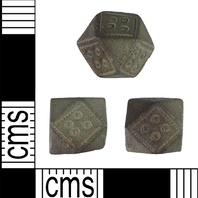
Viking Objects
Polyhedral Weight (LIN-752A9C)
This copper-alloy weight is of a type common within the Scandinavian diaspora. This example has fourteen sides and four dots on each of the rectangular sides. These weights were adopted by the Vikings from Middle Eastern examples and appear to have become a de facto weight standard for traders. Weights are an important form of evidence for Viking Age commerce and the use of standards across the different economic systems within which Vikings were integrated. Many of the weights discovered, particularly ones in Ireland and those of Arabic type, suggest that a standardized system of weights existed in some areas. These standard weights, alongside standard values of silver, are what allowed the bullion economy of Viking occupied areas to function. A bullion economy was a barter economy that relied on the exchange of set amounts of precious metal in various forms, such as arm-rings or coins, for tradable goods, such as food or textiles. Each merchant would have brought their own set of weights and scales to a transaction to make sure that the trade was conducted fairly.
Read More
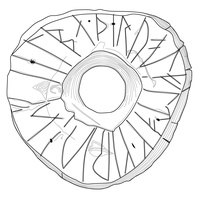
Viking Designs
Drawing of the Saltfleetby Spindle Whorl
Drawing of a lead alloy spindle whorl from Saltfleetby, Lincolnshire showing part of the runic inscription. For further information, see the entry for the original item.
Read More

Viking Talks
Danelaw Saga
Invade … immigrate … integrate … inspire. The exhibition ‘Danelaw Saga’ ran from 15th December 2017 to 8th April 2018 and told the tale of how the Vikings shaped the East Midlands. In the 860s the Great Heathen Army invaded the East Midlands, agreeing peace with the Anglo-Saxon King, Alfred the Great, in the 870s. The agreement established the Danelaw where Viking laws and government reigned, giving the Vikings half of England to rule. They settled in the five boroughs of the Danelaw (Derby, Leicester, Lincoln, Nottingham and Stamford) and integrated with the existing population. The legacy of these settlers can still be seen today in place-names like Gunthorpe, Nottinghamshire, named after Gunnhild, a woman with a Viking name. This film about the exhibition ‘Danelaw Saga’ tells a local story of Viking culture with artefacts, maps and medieval documents from Manuscripts and Special Collections at the University of Nottingham and from regional museums. The exhibition presented an opportunity to see extraordinary Viking works brought together and to learn about the places whose names evoke the Viking past. Visitors could map the routes of Viking expeditions, view coins brought from the Middle East to the East Midlands, and explore their heritage further through artefacts and jewellery worn by the Viking women that settled in the East Midlands. ‘Danelaw Saga’ tells the story of Viking heritage hidden in plain sight, from place names in use since they were given by the Vikings to modern literature inspired by the East Midlands’ own Viking past. ‘Danelaw Saga’ uncovers the legacy of the Vikings on our doorstep.
Read More
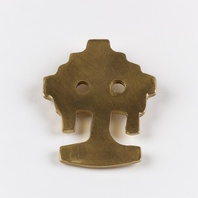
Viking Objects
Reproduction Jewellery Die Stamp
A copper alloy die for creating pressed silver or gold pendants. The original on which this is based had traces of interlace decoration. The presence of finds like this suggests that high-status jewellery production took place in the northern Danelaw.
Read More
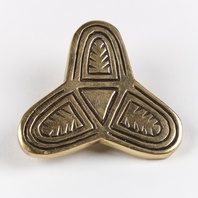
Viking Objects
Reproduction Trefoil Brooch
A reproduction, copper alloy trefoil brooch of a type that would have been common in the Danelaw. Trefoil brooches were characteristically Scandinavian women’s wear. However, many examples found in the East Midlands were probably made in the Danelaw, and may have been copies of Scandinavian styles, instead of being imported from Scandinavia. This example was found near Lincoln. Scandinavian brooches came in a variety of sizes and shapes which included disc, trefoil, lozenge, equal-armed, and oval shapes. The different brooch types served a variety of functions in Scandinavian female dress with oval brooches typically being used as shoulder clasps for apron-type dresses and the rest being used to secure an outer garment to an inner shift. Anglo-Saxon brooches do not match this diversity of form with large disc brooches being typical of ninth century dress styles with smaller ones becoming more popular in the later ninth and tenth centuries. However, since disc brooches were used by both Anglo-Saxon and Scandinavian women they are distinguished by their morphology. Scandinavian brooches were typically domed with a hollow back while Anglo-Saxon brooches were usually flat. Moreover, Anglo-Saxon brooches were worn singly without accompanying accessories.
Read More
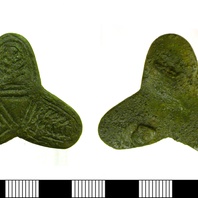
Viking Objects
Trefoil Brooch (LEIC-A43E83)
Trefoil brooches were characteristically Scandinavian women’s wear. However, many examples found in the East Midlands were probably made in the Danelaw, and may have been copies of Scandinavian styles, instead of being imported from Scandinavia. This example was found near Lincoln. For more information on Scandinavian jewellery in England check out our blog: Brooches, Pendants and Pins: Scandinavian Dress Accessories in England.
Read More
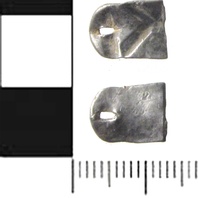
Viking Objects
Mystery Hacksilver
A fragment of silver from an unidentified object. The piece has been pierced at one end but may have come from an armring or other piece of jewellery. As hacksilver, it would have been used to pay for items by weight of silver.
Read More
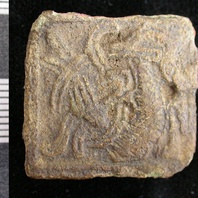
Viking Objects
Square Mammen Style Brooch ( LEIC-6AF276)
This small brooch features a bird depicted in the Mammen style. This style of brooch appears to have been produced in the Danelaw but, generally, Mammen-style decoration is rare in Britain. This brooch from Linwood, Lincolnshire, is paralleled by examples from West Stow Heath, Suffolk, and Bergh Apton, Norfolk, but further examples from Cambridgeshire and East Anglia were found in 2015 and 2016. It is a type which has Carolingian-inspired shapes and Scandinavian decoration. Such brooches were an accessory for women who wore Scandinavian dress. For more information on Scandinavian jewellery in England check out our blog: Brooches, Pendants and Pins: Scandinavian Dress Accessories in England.
Read More
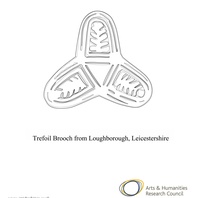
Viking Designs
Drawing of a Trefoil Brooch
A drwaing of a copper alloy trefoil brooch of a type that would have been common in the Danelaw. Trefoil brooches were characteristically Scandinavian women’s wear. However, many examples found in the East Midlands were probably made in the Danelaw, and may have been copies of Scandinavian styles, instead of being imported from Scandinavia. Scandinavian brooches came in a variety of sizes and shapes which included disc, trefoil, lozenge, equal-armed, and oval shapes. The different brooch types served a variety of functions in Scandinavian female dress with oval brooches typically being used as shoulder clasps for apron-type dresses and the rest being used to secure an outer garment to an inner shift. Anglo-Saxon brooches do not match this diversity of form with large disc brooches being typical of ninth century dress styles with smaller ones becoming more popular in the later ninth and tenth centuries. However, since disc brooches were used by both Anglo-Saxon and Scandinavian women they are distinguished by their morphology. Scandinavian brooches were typically domed with a hollow back while Anglo-Saxon brooches were usually flat. Moreover, Anglo-Saxon brooches were worn singly without accompanying accessories.
Read More
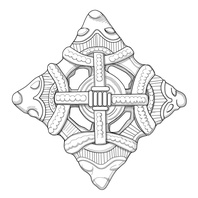
Viking Designs
Drawing of a Lozenge Brooch
Drawing of a copper alloy lozenge brooch in the Borre style. This type of brooch was common throughout the Danelaw in the Viking Age and was used as an accessory by women who wore Scandinavian dress. Scandinavian brooches came in a variety of sizes and shapes which included disc, trefoil, lozenge, equal-armed, and oval shapes. The different brooch types served a variety of functions in Scandinavian female dress with oval brooches typically being used as shoulder clasps for apron-type dresses and the rest being used to secure an outer garment to an inner shift. Anglo-Saxon brooches do not match this diversity of form with large disc brooches being typical of ninth century dress styles with smaller ones becoming more popular in the later ninth and tenth centuries. However, since disc brooches were used by both Anglo-Saxon and Scandinavian women they are distinguished by their morphology. Scandinavian brooches were typically domed with a hollow back while Anglo-Saxon brooches were usually flat. Moreover, Anglo-Saxon brooches were worn singly without accompanying accessories.
Read More
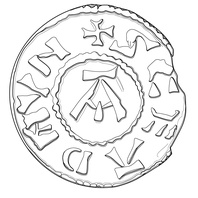
Viking Designs
Drawing of a St Edmund Penny
Between 895 and 915, Scandinavian settlers in East Anglia minted a series of pennies and half pennies with the inscription SCE EADMVND REX (St Edmund the king). These coins appear to have been used widely throughout the Danelaw, and a large number of them were discovered in the Cuerdale Hoard from Lancashire.
